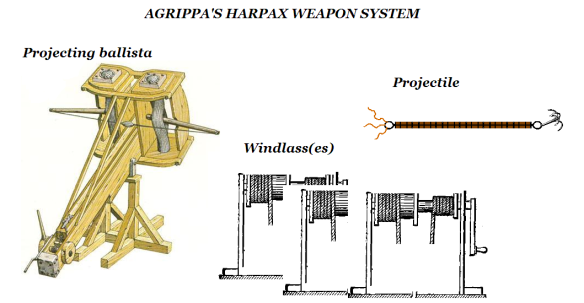HARPAX Roman word for the Greek harpagos or grappling hook used by the Roman NAVY; a combination harpoon and grappling iron consisting of a spar five cubits (2.25m, or 7ft 3in) long with a ring at each end. An iron hook was fastened to one of the rings, and a large number of ropes, twisted together into one cord, to the other. Fitted for use with the ballista, it would be embedded in an enemy vessel when fired, enabling the ship to be hauled in and boarded. An iron casing surrounded the spar, preventing the enemy from hacking it free.
The harpax enjoyed its greatest hour at ACTIUM, on September 2, 31 B. C., when the fleet of Octavian (AUGUSTUS) routed the ships of Antony and Cleopatra. Using the lighter Liburnian vessels, Agrippa, Octavian’s admiral, moved around Antony’s heavier ships, pinning and boarding them.
The naval Battle of Actium (Marc Anthony and Cleopatra versus Octavian) saw yet another ingenious new naval weapon, the harpax, an iron grapple hurled by a catapult at an enemy ship, which was then hauled in by a winch for boarding.
Both sides gathered large fleets and assembled legions, but Octavian, with his normal prudence, took his time. Finally, in 31 he set out with hundreds of ships and 40,000 men, landing in Greece and marching south to Mikalitzi, north of Nicopolis on the Bay of Comarus. Antony, possessing a like number of land forces, also had at his command a combined Roman-Egyptian fleet of 480 ships. The advantage rested with Antony in naval terms, because his vessels were large and heavy. Octavian, however, possessed two elements that were to prove pivotal to the outcome: his admiral AGRIPPA, and his lighter Liburnian ships, which were equipped with the HARPAX. Antony, encamped just south of Actium, nevertheless stood a good chance of victory.
The battle was really two encounters in a single day, the fierce naval conflict in the morning and a halfhearted rout on land that afternoon. The naval engagement began with the two fleets facing one another. Octavian’s force was divided into three sections – a center and two wings. Agrippa commanded the northern wing and was admiral in chief. ARRUNTIUS led the center, and Octavian was in charge of the southern wing. On the Egyptian side, Antony took command of the northern squadrons, opposite Agrippa. Marcus Octavius was opposed to Arruntius, and Savius sailed against Octavian’s ships. Cleopatra headed a reserve squadron of 60 ships behind the center of the Egyptian fleet.
The tactical advantage would fall to the commander who penetrated the other’s flanks, and here the battle was won by Agrippa. Antony fought valiantly, but the unreliable and disloyal ships of his center and south wing broke ranks. Cleopatra sailed to safety, probably signaled by Antony to do so, although the historian DIO CASSIUS dismissed her flight as the act of a woman and an Egyptian. Antony, with his own ship pinned by a harpax, transferred to another vessel and also fled toward Egypt.
